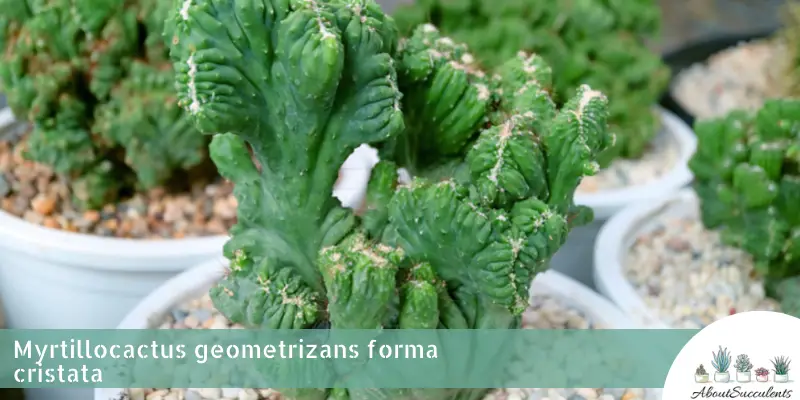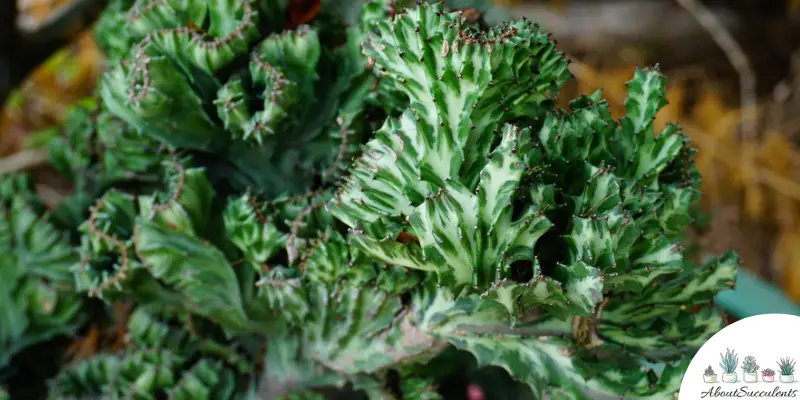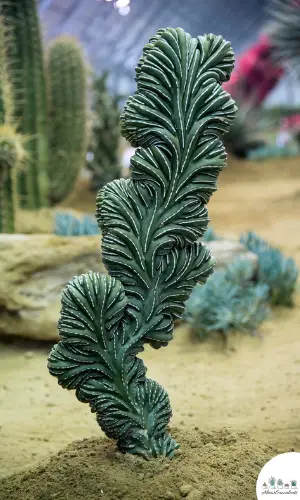
Myrtillocactus geometrizans forma cristata is a fascinating succulent that has an unusual charm about it. This cactus is identified by its robust, waxy-textured branches that fan out over an upright but stocky trunk. As the branches spread, they form wavy structures that give the illusion of sculpted, blue-green plumes.
Because it’s difficult to state its name to a nursery, you can refer to the succulent plant’s common names which are Dinosaur Back Plant, Crested Blue Flame, Crested Blue Candle, and Crested Blue Myrtle. It’s part of the Cactaceae family and is native to Central and Northern Mexico.
Dinosaur Back Plant can grow as tall as 13-feet (4m) while its stems can reach a height of 9-feet (3m) with a diameter of 3-feet (8cm). While categorized as a cactus, Myrtillocactus geometrizans has small spines that are few in number.
If properly cared for, this alluring succulent will bloom small, exquisite cream-colored flowers that measure 1.45 inches (3.7cm) in the summertime. As a special reward, Dinosaur Back Plant will also bear small fruits that are very sweet and have a similar appearance to a plum. These fruits are popularly sold in Mexico.
General Information
Also known as: Dinosaur Back Plant, Crested Blue Flame, Crested Blue Candle, and Crested Blue Myrtle.
Plant Family: Cactaceae
Origin: Central and Northern Mexico
Height: 9-feet (3m)
Exposure: Partial to full sunlight but preferably full sunlight.
Water Needs: Sparingly; only water the soil when it’s 100% dry.
Soil Type: Commercial soil mix or sandy soil with added perlite, pumice or lava rocks for better drainage.
Soil pH: 5 to 6.5
How To Grow And Care For Myrtillocactus Geometrizans Forma Cristata

Myrtillocactus geometrizans forma cristata’s beguiling appearance makes it a favorite of horticulturists looking to spruce up their succulent garden.
If you’re in the market for a succulent plant that’s easy to grow and care for, put Dinosaur Back Plant on the top of your list. As a cactus, it’s highly durable to changes in weather conditions and can survive long periods of time without water.
Follow our simple tips below to get the most of Myrtillocactus geometrizans forma cristata.
Sunlight
Crested Blue Myrtle prefers getting a daily dose of the sun’s full rays. This is especially true for plants that exceed 3.9-feet (120cm). Thus, it’s better to grow Crested Blue Myrtle in an outdoor garden where it can be exposed directly to the morning sun for 4 to 6 hours every day.
If your region experiences winter or frosty temperatures where the mercury can drop below 30° F (-1.1° C), it’s recommended to plant Myrtillocactus geometrizans in a pot that can be transferred indoors. Just be sure to situate the cactus near a window where it can get partial to full sunlight for 4 to 6 hours each day.
Watering

Like other succulent plants, Myrtillocactus geometrizans thrives better with few watering schedules. Myrtillocactus geometrizans stores water in its stems and can survive extended periods of drought better than other species.
In fact, watering the soil too frequently will immerse the roots longer in a moist environment and cause its cells to rupture which will lead to disease.
The best way to approach watering is to first test the soil’s level of dryness. An effective way is to insert a dry stick at least an inch deep into the soil. If the stick comes out dry, then it’s time to water the soil.
Always water the soil and never the plant itself. Give the soil a thorough soaking. If Dinosaur Back Plant is planted in a pot, you can stop once excess water leaks out of the drain hole.
Ideally, Myrtillocactus geometrizans is watered every seven to 10 days but to be sure, check the soil’s dryness first.
Pot and Soil
A pot that’s made of ceramic material or terracotta is best for Myrtillocactus geometrizans. These types of materials allow excess moisture to escape from the soil and dry it out faster.
Choose a pot that’s approximately 1.5 times the size of the plant to allow its roots more room to grow. Also, make sure the bottom of the pot has a drain hole with a mesh net cover to allow excess water to filter through.
Plant Crested Blue Myrtle in a variety of soil that’s well-draining. A commercial soil mix is good and sandy soil will work just fine. To improve drainage, add pumice, lava rocks, and perlite.
If you plant Crested Blue Myrtle in a pot, it might not get enough nutrients compared to one that’s planted in an outdoor garden.
To be sure that your cactus stays healthy, fertilize the soil every 40 days. Follow the instructions on the label on how much water to use in order to properly dilute the fertilizer.
How To Propagate Myrtillocactus Geometrizans Forma Cristata
If you’re happy with Myrtillocactus geometrizans and want to increase its number, the good news is that the species can be propagated from stem cuttings.
Step 1: Choose a healthy stem.
Step 2: Cut off the stem from the main plant by using a sharpened and sterilized knife or garden shears. It’s very important to perform a clean cut to ensure successful propagation.
Step 3: Place the stem cuttings in a dry area and allow it to grow hardened calluses over a few days.
Step 4: Once the calluses have formed, place the stem cuttings on top of sandy soil.
Step 5: Lightly water the soil and place the pot near an area that receives 4 to 6 hours of direct sunlight every day.
After a few days, the roots will form and take hold in the soil. From here, water the soil only when it’s completely dry.
Frequently Asked Questions
Is Myrtillocactus Geometrizans Forma Cristata Toxic For Cats And Dogs?
Myrtillo geometrizans forma cristata isn’t included in the list of succulent plants that are toxic to cats and dogs that can be found on the website of the American Society for the Prevention of Cruelty to Animals (ASPCA).
Why Is My Myrtillocactus Geometrizans Forma Cristata Dying?
If your Myrtillocactus geometrizans doesn’t look healthy, it might be close to death. There are 2 possible reasons for this: Overwatering and the presence of pests. You can still save Crested Blue Myrtle by addressing these factors right away.
Overwatering
Overwatering is the number one cause of death of succulent plants. As durable as Dinosaur Back Plant is, its roots remain vulnerable to water if the soil remains in a moist condition for an extended period.
You’ll know that root rot has taken place if you notice discoloration on the stems. If you see the blue-green stems taking on a dark yellow to brownish color, this is evidence of rotting taking place inside the plant.
The first thing that you have to do is to get a sterilized knife and cut out the infected parts of the plant. Then, gently remove Dinosaur Back Plant from the pot and shake out the excess soil so you can closely see how much of the roots have rotted.
Cut out the rotten roots and place the plant in a dry area to allow it to rest while you begin the process of repotting.
Fill out the pot with a fresh batch of sandy soil or a commercial succulent mix and replant Dinosaur Back Plant.
Pest Infestation
Succulents attract pests such as mealybugs and aphids because of the sap that can be found in their stems.
Myrtillocactus geometrizans is no exception.
If you don’t remove the pests from Crested Blue Myrtle, these insects could drain it of nutrients that are contained in the sap.
You can keep pests away by spraying Crested Blue Myrtle with a natural insecticide like neem oil. If you notice cotton-like substances on the plant, remove them with a cotton ball that’s soaked in 70% isopropyl alcohol. These white substances are from the mealybugs.
Yes, Myrtillocactus geometrizans forma cristata produces small, cream-colored flowers in the summertime.
Last Updated on June 9, 2022 by Sofia Lara